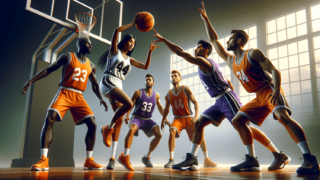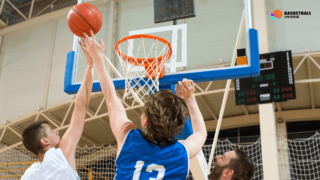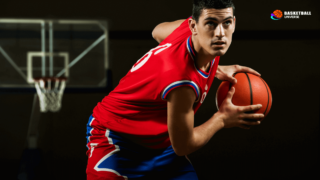
Origins of Streetball and Playground Legends
Written by: Basketball Universe
Last updated:

From the blacktops of inner cities to the sun-soaked playgrounds along the coast, streetball holds a unique and captivating place in the world of basketball. A game with roots that run deep into the heart of urban culture, streetball has given rise to some of the sport’s most unforgettable characters and mesmerizing moments. In this thrilling journey, we will explore the origins of streetball, uncover the legends that graced these hallowed grounds, and reveal the indelible mark they’ve left on both amateur and professional basketball. If you live for the acrobatic slams, flashy crossovers, and relentless passion of pickup games, then fasten your seatbelts, because we’re about to immerse ourselves in everything that the playground and streetball have to offer!
Origins of Streetball and Playground Legends
The origins of streetball can be traced back to the early 20th century in urban centers across the United States, such as New York City, Philadelphia, and Los Angeles. The sport emerged as a gritty and informal version of basketball, played on outdoor courts with a focus on individual flair and creativity. Streetball gained popularity in the 1960s and 1970s, a golden age of playground legends, driven by the desire for a high-energy, unfiltered game outside of the confines of organized leagues. Rucker Park, Venice Beach, and The Cage became iconic venues that birthed a new generation of style, self-expression, and influential players, forging the rich legacy of this unparalleled sport.
Basketball’s Unconventional Path: The Rise of Streetball
Before diving into the intricacies of streetball, it’s essential to understand its connection to basketball’s humble beginnings. When Dr. James Naismith invented basketball in 1891, the game was designed to be played indoors with a focus on teamwork and physical fitness. Over time, as the sport flourished and evolved, it expanded to outdoor courts in various neighborhoods, paving the way for the emergence of the gritty and engaging spectacle known as streetball.
Streetball and the Urban Environment
The widespread growth of basketball across America’s urban centers led to a reimagining of the game’s structure and purpose, giving rise to streetball. As crowded city environments provided limited access to space and resources, makeshift outdoor courts became the stages for energetic and passionate players looking to showcase their skills. Unlike the regimented and formal structure of organized basketball, streetball was played with an emphasis on personal flair and creativity, allowing for individualistic expressions of talent and ingenuity.
Freedom of Expression and Style
One of the defining characteristics of streetball is the celebration of individual ingenuity, a departure from the standardized nature of professional basketball. This expanding game provided ample breathing room for players to display jaw-dropping maneuvers, such as no-look passes, flashy dribbling, and acrobatic dunks. Streetball also saw the rise of unique and flamboyant styles of play, as no two games were the same. Amidst this phenomena, legends like Earl “The Goat” Manigault, Pee Wee Kirkland, and Joe “The Destroyer” Hammond swiftly rose to fame, securing their spots in the ever-expanding annals of basketball history.
Rucker Park: The Mecca of Streetball
Establishing a Playground Dynasty
Rucker Park, located in Harlem, New York, soon became the epicenter of streetball and its burgeoning culture. Initially built in 1956 alongside a playground, Rucker Park’s notoriety emerged from the efforts of local educator and community leader Holcombe Rucker. Rucker’s tenacity in organizing and fostering youth basketball tournaments at the park led to the influx of talent and potential future legends eager to prove themselves on this iconic stage.
Legendary Games and Moments
The hallowed grounds of Rucker Park have been the stage for countless impressive feats, unforgettable moments, and legendary clashes between streetball icons and established NBA stars. Rucker Park became a veritable proving ground, where skilled streetballers earned badges of honor through hard-fought battles against celebrated NBA players. Whether it was Kareem Abdul-Jabbar, Dr. J, or Wilt Chamberlain locking horns with local streetball legends, the park offered a unique canvas for these epic showdowns to unfold.
Other Iconic Streetball Venues
Venice Beach: Bouncing to the West Coast
While Rucker Park cemented its status on the East Coast, streetball’s influence soon spread to the attractive beaches of Southern California. Venice Beach became a hotbed for dazzling streetball demonstrations, drawing spectators from far and wide to witness the spectacle. With its vibrant atmosphere and laid-back appeal, Venice Beach offered an ideal setting for the burgeoning West Coast streetball culture. Players like Ron “The Dancing Bear” Pitts and Larry “Bone Collector” Williams rose to prominence as Venice Beach icons, showcasing their streetball prowess amidst the beautiful coastal backdrop of the Pacific Ocean.
The Cage: Where Warriors Are Made
Barely a few miles away from the legendary Rucker Park lies another iconic streetball location, the West Fourth Street Courts, famously known as “The Cage.” Known for its unforgiving environment, the court’s tightly enclosed quarters forged a unique battlefield where only the hardiest of basketball warriors thrived. The Cage has showcased an array of remarkable players, including streetball legend Ed “Booger” Smith and future NBA star Rod Strickland. Its intense and relentless atmosphere has been a breeding ground for resolute talent, contributing significantly to the streetball legends roster.
From Playground to NBA: The Impact of Streetball in Professional Basketball
The Infusion of Streetball Skills in NBA Play
As the popularity of streetball grew, the NBA began to take notice of the wealth of talent incubating on these playground courts. Gradually, players from streetball backgrounds worked their way up the ranks, bringing with them unique stylistic elements that infused the NBA with a new-found sense of excitement and flair. Guards like Jason “White Chocolate” Williams, Allen Iverson, and even Michael Jordan owed a part of their astonishing individual skills to the playgrounds. As the NBA embraced this exciting dynamic, elements of streetball culture, such as flashy dribbling and high-flying dunks, became integral highlights of the professional game.
The AND1 Mixtape Tour and Streetball’s Explosive Popularity
The convergence of streetball and mainstream basketball culture became even more evident with the inception of the AND1 Mixtape Tour in 1998. Originally intended as a marketing tool to promote their sportswear line, AND1’s mixtape distribution helped catapult streetball into the limelight. The tour, featuring top streetball players like Rafer “Skip to my Lou” Alston and Philip “Hot Sauce” Champion, showcased a blend of electrifying basketball and unparalleled showmanship. Its success was instrumental in shedding light on streetball legends and the long-lasting influence they had on the game of basketball.
Documentaries and Films: Shining the Light on Streetball and Playground Legends
Hoops Dreams: The Grind on the Streets of Chicago
In 1994, a groundbreaking documentary film titled ‘Hoop Dreams’ was released, chronicling the lives of two Chicago high schoolers, William Gates and Arthur Agee, during their challenging quest to become professional basketball players. The film offers a genuine and heart-wrenching insight into the world of streetball, underscoring the sport’s impact on the local community and its enduring influence on players’ lives both on and off the court.
The Street Stops Here: A Journey Through Rucker Park’s Legends
Diving deep into streetball lore, ‘The Street Stops Here’ tells the story of one of the most prominent New York City high school basketball coaches, Bob Hurley, as he dedicates his life to transforming the lives of young, at-risk athletes. The documentary offers a unique glimpse into the captivating world of playground legends and their rise to fame, shedding light on the remarkable and enduring stories of Rucker Park and its streetball icons.
He Got Game: A Cinematic Ode to Playground Legends
In 1998, acclaimed filmmaker Spike Lee released ‘He Got Game,’ a drama centered around a high school basketball prodigy, Jesus Shuttlesworth, portrayed by NBA icon Ray Allen. The film features an exploration of streetball culture and the playground court as a central element in shaping basketball players’ journey toward fame and success.
The Magnitude of Streetball’s Impact on Today’s Basketball Culture
As the landscape of basketball continues to expand and grow, streetball and its illustrious legends remain a symbol of the sport’s essence, deeply ingrained in basketball’s cultural fabric. The rise of YouTube stars and social media influencers perpetuating streetball-like moves and techniques further serves as a testament to the profound impact that playground legends have had on the game. As long as there is a hoop, a ball, and passion for the game, the spirit of streetball will continue to inspire and fuel the dreams of aspiring five-on-five warriors, both on the playground and the hardwood.
Streetball’s Enduring Legacy and the Rise of New Stars
As the world of basketball continues to evolve, streetball remains influential, having left an indelible mark on the game’s legacy. The global embrace of streetball has led to further development and emergence of new playground legends, inspiring generations to follow in their footsteps.
Streetball in the Internet Era
The internet age has brought about a shift in how streetball is consumed and appreciated. Platforms like YouTube and Instagram have leveraged streetball’s visual and dynamic elements, helping to document, share, and revive the culture. From viral dunk contests to shooters defying the laws of physics, these social media platforms have granted a newfound appreciation for streetball talent, continuously pushing the culture forward.
Streetball Tournaments and Their Global Appeal
While streetball may have roots deeply embedded in American culture, its global influence cannot be understated. Today, streetball transcends continents, fostering an immense following in countries like Lithuania, China, and the Philippines. Numerous international streetball tournaments and events, such as Quai 54 in Paris and Red Bull King of the Rock, continue to highlight the sport’s vibrant appeal and have become a cornerstone of streetball’s ongoing legacy.
The Success of Collegiate and Professional Streetball Stars
While many iconic streetballers have inspired legions of aspiring athletes, some have gone on to achieve tremendous success in the collegiate and professional basketball realms. Players like Rafer Alston and God Shammgod, who gained prominence on the playground scene, later made their mark on the NBA, showcasing the harmonious relationship between streetball and professional basketball. Additionally, collegiate programs are often scouting for talent in streetball courts, demonstrating the significant potential and opportunity that lies within these hallowed grounds.
Women in Streetball and the Emergence of Female Legends
Though streetball is often recognized for its male players, the undeniable contribution of female athletes within the sport cannot be overlooked. The rise of women streetball players has since changed the narrative, paving the way for more gender-inclusive representation in this captivating basketball universe.
Breaking Gender Stereotypes
The world of streetball has historically been male-dominated, but this has not dissuaded female players from making their presence felt. Women such as Cynthia “Twiggy” Cooper, Robin “Bird” Kennedy, and Karen “Special K” Blanford have demonstrated exceptional skill and talent, shattering stereotypes and proving that gender is not a limitation in the pursuit of greatness. Female streetballers have since been acknowledged for their on-court prowess and undeniable influence on the broader basketball culture.
Organized Leagues and Showcases for Women’s Streetball
In an effort to further recognize and promote women’s involvement in streetball, several organizations and events have been established, catering specifically to female talent in this domain. The Bballnationals, for instance, is a women’s streetball tournament in Canada, designed to bring the best national talent to the forefront. Events like these strive to not only offer a platform for showcasing female streetballers but also to elevate the game for women on a broader level.
Frequently Asked Questions
In this section, we delve into some of the most common questions related to streetball and playground legends, offering insights and answers to satiate your curiosity about this fascinating basketball subculture.
What is the difference between streetball and professional basketball?
Streetball is an informal, often unregulated version of the sport, played primarily on outdoor courts, emphasizing individual skill and flair rather than teamwork. Professional basketball, by contrast, is organized, has a regulatory structure, and focuses more profoundly on team play, strategies, and specific roles within the game.
Who are some famous streetball legends?
Some renowned streetball legends include Earl “The Goat” Manigault, Pee Wee Kirkland, Joe “The Destroyer” Hammond, and Rafer “Skip to my Lou” Alston, among others. These players are famous for their mesmerizing skills, electrifying moves, and contributions to streetball culture.
Where can I watch streetball games?
Streetball games are typically held at outdoor courts in various urban centers, with notable locations such as Rucker Park in New York City, Venice Beach in Los Angeles, and The Cage in Manhattan. Additionally, you can find streetball gameplay footage online on platforms like YouTube and Instagram.
What are the most popular streetball venues?
Some of the most iconic streetball venues include Rucker Park in Harlem, Venice Beach in Los Angeles, and The Cage in Manhattan. These locations hold historical significance within the streetball community and have given rise to many legends of the sport.
Has any streetball player ever made it to the NBA?
Yes, several streetball players have transitioned to the NBA, such as Rafer Alston and God Shammgod. These players have managed to translate their unique streetball skills to the professional environment, showcasing how interconnected the two realms of basketball can be.
Are there any notable streetball movies or documentaries?
Indeed, there are several documentaries and films that highlight the world of streetball, such as ‘Hoop Dreams,’ ‘The Street Stops Here,’ and Spike Lee’s ‘He Got Game.’ These productions focus on various aspects of streetball culture and its influence on basketball as a whole.
Do streetball players get paid?
While most streetball players don’t receive any compensation, some successful players have managed to earn a living through competitive games, exhibition matches, or as part of professional streetball tours like the AND1 Mixtape Tour. However, such opportunities are relatively rare compared to professional basketball.
Is streetball played only in the United States?
While streetball’s origins can be traced back to urban centers in the United States, its influence has spread globally over time. Today, streetball is played and celebrated in countries like Lithuania, China, and the Philippines, with several international streetball events held worldwide.
Are there any tournaments or leagues specifically for streetball?
Yes, there are various tournaments, leagues, and events focused on streetball, such as the AND1 Mixtape Tour, the Quai 54 in Paris, and the Red Bull King of the Rock. These events showcase streetball talent and help maintain the sport’s popularity and influence.
What role do women play in streetball, and are there any female streetball legends?
Women have made significant contributions to the streetball scene, with players like Cynthia “Twiggy” Cooper, Robin “Bird” Kennedy, and Karen “Special K” Blanford breaking gender stereotypes and proving themselves as exceptional talents in the sport. Various organizations and events have since emerged to support and promote women’s involvement in streetball, celebrating their skills and influence within the sport.
Featured Posts
- No pillar pages found.





